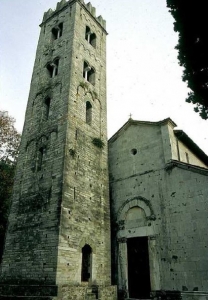
Information
Foundation:
XI century
District/Location:
Lucca, Pieve di Brancoli
District:
Piana di Lucca


This building, along with the Church of S. Alessandro of Lucca and the Parish Church of Valdottavo, is one of the finest and most important examples of the new architectural and figurative language of the mid-11th century, characterised by the revival of the early Christian style. It still has its exceedingly well preserved original altars, pulpit and christening font, such that it has been listed as a national monument since 1876.
Pieve di Brancoli, Lucca
The oldest mention of S. Giorgio in Brancoli as a Parish Church dates to 1097, although sources demonstrate the existence of a church dependent on the Parish Church of Sesto from 772 to the first half of the 11th century. The division of the oldest and biggest parish is undoubtedly related to the importance that the Brancoli area assumed in this period. It experienced such demographic development, that it became impractical to oblige the population to cross the river to reach the old Parish Church of Sesto.
In the second half of the century many religious institutions were founded or restored in the Brancoli area, such as the establishment of a Rectory at S. Michele in Tramonte and the re-consecration of S. Maria in Piazza. These initiatives are evidence of the attention given to this area as part of the spiritual reforms promoted by Bishop Anselmo da Baggio, later Pope Alessandro II, and ex-resident Matilde di Canossa.
The "Estimo" of 1260 records S. Giorgio as having various dependent churches, all having sprung from small hill settlements, whereas the Parish Church stands alone, in a barycentric position.
The face of the external walls with large alternated marble blocks framed by cornerstones, the precise proportions and the monolithic columns topped by neo-classical capitals are all evidence of this building’s belonging to the concept of architecture renewed by Alessandro II, in line with his reformatory principals.
The interior preserves its original sculptural apparatus, including the extremely rare and high quality altar on small columns, linked to the name Raito, twice signatory of the holy water stoop (unfortunately recently stolen).
Just behind are the christening font and ambo supported by lions attributed to the Lombard-Lucca artistic group known as Guidi, active in Lucca between the late 12th and early 13th century.
There is also a 13th century painted cross in the apse, and an extensive fresco decoration in the left aisle where a late 14th century Annunciation attributed to Giuliano di Simone can still be seen. The church also conserves a piece of glazed earthenware from the Robbiana School.
In the second half of the century many religious institutions were founded or restored in the Brancoli area, such as the establishment of a Rectory at S. Michele in Tramonte and the re-consecration of S. Maria in Piazza. These initiatives are evidence of the attention given to this area as part of the spiritual reforms promoted by Bishop Anselmo da Baggio, later Pope Alessandro II, and ex-resident Matilde di Canossa.
The "Estimo" of 1260 records S. Giorgio as having various dependent churches, all having sprung from small hill settlements, whereas the Parish Church stands alone, in a barycentric position.
The face of the external walls with large alternated marble blocks framed by cornerstones, the precise proportions and the monolithic columns topped by neo-classical capitals are all evidence of this building’s belonging to the concept of architecture renewed by Alessandro II, in line with his reformatory principals.
The interior preserves its original sculptural apparatus, including the extremely rare and high quality altar on small columns, linked to the name Raito, twice signatory of the holy water stoop (unfortunately recently stolen).
Just behind are the christening font and ambo supported by lions attributed to the Lombard-Lucca artistic group known as Guidi, active in Lucca between the late 12th and early 13th century.
There is also a 13th century painted cross in the apse, and an extensive fresco decoration in the left aisle where a late 14th century Annunciation attributed to Giuliano di Simone can still be seen. The church also conserves a piece of glazed earthenware from the Robbiana School.
Scopri altre attrazioni vicino a Parish Church of Saint George in Brancoli
See allYou may also like..
See allFind more
0











